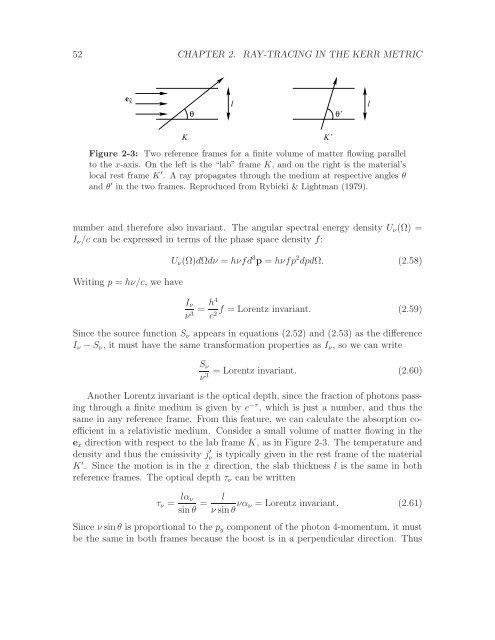Radiation Transport Around Kerr Black Holes Jeremy David ...
Radiation Transport Around Kerr Black Holes Jeremy David ...
Radiation Transport Around Kerr Black Holes Jeremy David ...
Create successful ePaper yourself
Turn your PDF publications into a flip-book with our unique Google optimized e-Paper software.
52 CHAPTER 2. RAY-TRACING IN THE KERR METRIC<br />
e x ^<br />
l<br />
θ θ’<br />
l<br />
K<br />
Figure 2-3: Two reference frames for a finite volume of matter flowing parallel<br />
to the x-axis. On the left is the “lab” frame K, and on the right is the material’s<br />
local rest frame K ′ . A ray propagates through the medium at respective angles θ<br />
and θ ′ in the two frames. Reproduced from Rybicki & Lightman (1979).<br />
K’<br />
number and therefore also invariant. The angular spectral energy density U ν (Ω) =<br />
I ν /c can be expressed in terms of the phase space density f:<br />
Writing p = hν/c, we have<br />
U ν (Ω)dΩdν = hνfd 3 p = hνfp 2 dpdΩ. (2.58)<br />
I ν<br />
ν = h4<br />
f = Lorentz invariant. (2.59)<br />
3 c2 Since the source function S ν appears in equations (2.52) and (2.53) as the difference<br />
I ν − S ν , it must have the same transformation properties as I ν , so we can write<br />
S ν<br />
= Lorentz invariant. (2.60)<br />
ν3 Another Lorentz invariant is the optical depth, since the fraction of photons passing<br />
through a finite medium is given by e −τ , which is just a number, and thus the<br />
same in any reference frame. From this feature, we can calculate the absorption coefficient<br />
in a relativistic medium. Consider a small volume of matter flowing in the<br />
eˆx direction with respect to the lab frame K, as in Figure 2-3. The temperature and<br />
density and thus the emissivity j ′ ν is typically given in the rest frame of the material<br />
K ′ . Since the motion is in the x direction, the slab thickness l is the same in both<br />
reference frames. The optical depth τ ν can be written<br />
τ ν = lα ν<br />
sin θ =<br />
l<br />
ν sin θ να ν = Lorentz invariant. (2.61)<br />
Since ν sin θ is proportional to the p y component of the photon 4-momentum, it must<br />
be the same in both frames because the boost is in a perpendicular direction. Thus
















